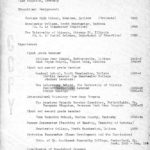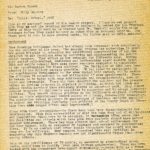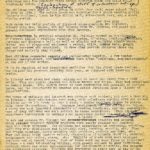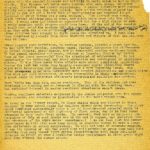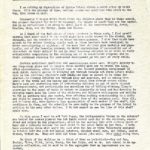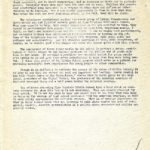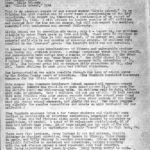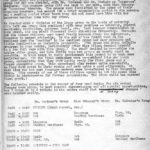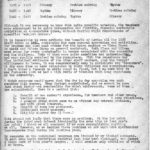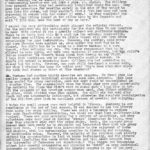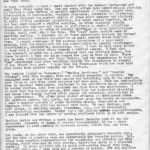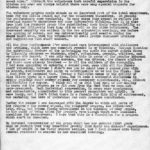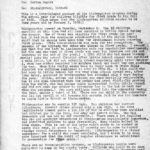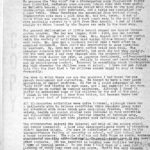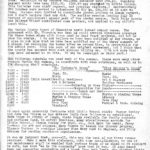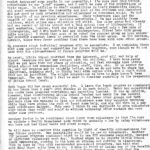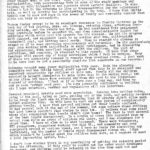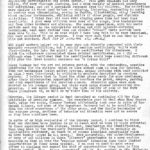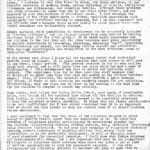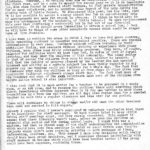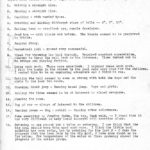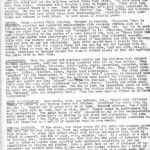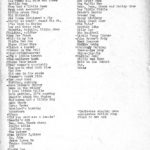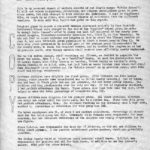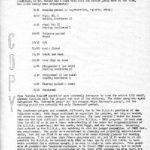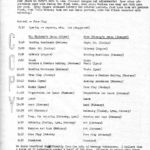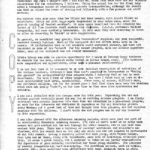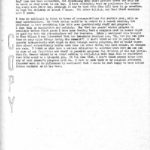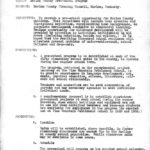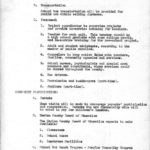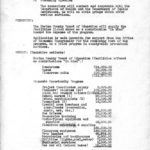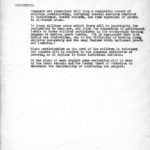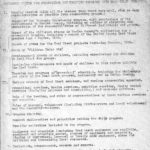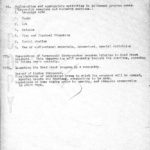Pine Mountain Settlement School
Series 04: ADMINISTRATION – Interim Directors
Series 09: BIOGRAPHY – Staff
Series 07: Directors
Mildred Mahoney
Correspondence 1963-1967(?)
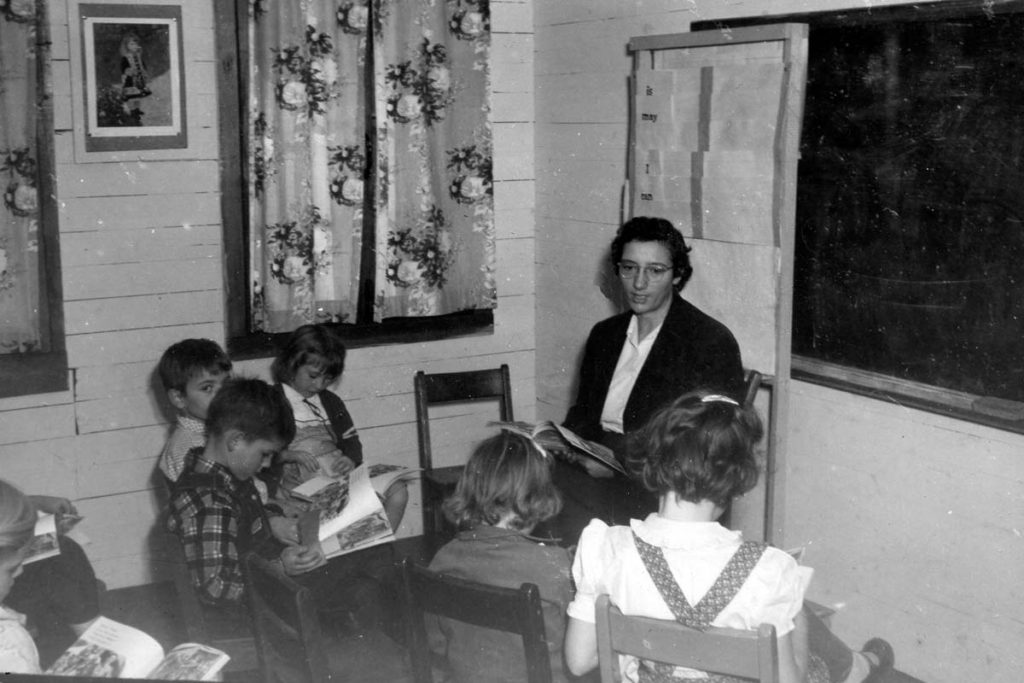
Miss Milly Mahoney in her classroom, 1954. [53_life_work_children_classes_1718.jpg]
TAGS: Mildred Mahoney Correspondence, kindergarten, Little School, hot lunch program, teachers, student volunteers, Head Start, school buses, Harlan County Board of Education, class schedules, swimming classes, reading readiness, music studies, physical education, library classes, science classes, ESEA, evaluations, class sizes, Harlan County Pre-School Program
MILDRED MAHONEY Correspondence
Teacher, First and Second Grades 1953 – 1964
Co-founder & Coordinator, Little School 1963 – ?
Kindergarten Teacher 1964 – ?
Part-time Secretary to Director Burton Rogers 1949 – 1972
Assistant to Director Robin Lambert 1997 – 1999
General Volunteer 1993 – 2000
Interim Director October 1996 – August 1997
Member, Board of Trustees 1973 – 2001,
Honorary Board Member 2001-2016
CONTENTS
Note: All reports are typewritten. All reports, except that of Rebecca Caudill, are carbon copies.
[mahoney_vita_001.jpg] Carbon copy of typewritten vita, 1941-1965; 1 page
Resume for Mildred M. Mahoney, Pine Mountain Settlement School, Pine Mountain, Kentucky, listing her education and experience. Education includes Manchester (IN) College (BS in Elementary Education, 1945) and The University of Chicago (MA in Social Science, Dept. of Education, 1950). Experience (1950-1965) includes first and second grade teaching, International Voluntary Work Camp Program, summer instructor at Manchester College, part-time instructor at University of Kentucky Southeast Community College, Coordinator of Pre-school Program at Pine Mountain, staff member, Head Start Training Programs at University of Kentucky and Eastern and Consultant, Harlan County Head Start Program.
[1963_mahoney_rept_001.jpg] Typewritten report re: “Little School,” September 14, 1963; p. 1 of 3 pages
To [PMSS Director] Burton Rogers from Milly Mahoney, a “personal report of the summer project.” The present program began in 1949 to enlarge “the educational opportunities of all the children in its [PMSS’s] immediate area by enriching and supplementing the public school program.” The program, in its 15th year, uses every PMSS resource available and employs both PMSS & public school staff and volunteers. The report lists progress in physical well-being due to hot lunches and school health services, in children’s ability to cooperate and accept responsibilities, attitudes toward school as a happy, interesting experience, and percentages of resident children enrolled in school and attending regularly. Also listed are disappointments and frustrations: “Facilities and efforts which have gone into projects should have netted greater [academic] achievement” according to teacher evaluations and standardized testing. “For some time teachers at PM have felt the great handicap borne by many children who entered school unprepared in varying ways for the experience.”
[1963_mahoney_rept_002.jpg] “Little School” report, continued – p. 2 of 3 pages
Mahoney describes organization of the summer program and its daily schedule: physical education and free play on the playground with Mr. [Charlie] Whitaker, library with Mrs. [Mary] Rogers, art and science with Mr. [Jerry] Workman, and music and general readiness experiences with Miss Mahoney. Describes activities in each class and the students’ degrees of compliance.
[1963_mahoney_rept_003.jpg] “Little School” report, continued – p. 3 of 3 pages
Mahoney continues description of activities in each class and the students’ varied degrees of compliance. “Very little was done with number readiness.” Reading readiness materials projected by the opaque projector…were popular and provided an introduction to the audio visual room.” Describes the varying levels of maturity in the students. “I do not feel that the summer experiences in this line were long enough or creative enough to make a long-tome difference on school achievement.”
[1964_caudill_impressions_001.jpg] Typewritten report by Rebecca Caudill Ayars, 1964; p. 1 of 2 pages
Mrs. Ayars writes about her impressions of Little School, beginning with a positive description of the teachers, “Milly [Mahoney], Jerry [Workman], Charlie [Whitaker], Mary [Rogers], and the Haraps, Elena and Eileen” and focuses on the qualities and contributions of each; describes Director Burton Rogers‘ leadership skills. Praises Ruth Boggs‘ work on daily hot lunches for the children and the volunteers who assisted her.
[1964_caudill_impressions_002.jpg] Ayars’ report, 1964, continued – p. 2 of 2 pages
During her six full school days of observation, Ayars noted “marked improvement in the children’s skills, in their awareness, and in their cooperation, and an increase in their joy in participation.” She described the good work of the volunteers, who were mainly boys and girls who had finished seventh grade at PMSS and remarked that employing youth in this program solved problems of youth idleness and joblessness. She concludes with the benefits of a head start for mountain children.
[1964_mahoney_rpt_001.jpg] Carbon copy of typewritten report re: “Little School,” October 31, 1964: p. 1 of 6 pages
To [PMSS Director] Burton Rogers from Milly Mahoney, “personal report of our second summer ‘Little School.’… in every sense a continuation of my report of the 1963 project.” Mahoney writes about “all additions and changes made for the second summer, but will not repeat … background and general philosophy.” Little School operated for six weeks, July 6 – August 13, for children eligible to enter first grade in 1964 and 1965; 32 children in “older” group; 13 children in “younger” group. There seemed to be more illness (virus) and unfavorable weather (unseasonable rain) than during the previous summer. She covers attendance statistics, school buses, insurance, PMSS’s expenses, cost to parents, lunch programs, and volunteer assistants’ schedules and statistics. The five teachers included Jerry Workman (art & science), Charlie Whitaker (physical education, Mary Rogers (library), Elena Harap (music), Milly Mahoney (reading readiness). Eileen Harap assisted where needed, Ruth Boggs supervised the lunch program, Polly Harris was the cook, Vernon Conley and Charlie Whitaker drove the buses.
[1964_mahoney_rpt_002.jpg] “Little School” report, continued – p. 2 of 6 pages
Mahoney reports on experimenting with size of the groupings, using homeroom teachers and dealing with the many problems of the smallest group. She shows an example of a schedule of one of the four different groupings that were tried out during the six weeks.
[1964_mahoney_rpt_003.jpg] “Little School” report, continued – p. 3 of 6 pages
Mahoney describes “the benefit of having all the 1963 staff again in 1964, continuing the same general approaches and activities” and having the extra support of the Haraps. She praises the Haraps for their work with the children and their assimilation with the other teachers; appreciates the high ratio of teachers with long experience in the community. She lists the factors that contributed to smoother day-to-day operations, describes problems that were encountered (but saw increased improvements compared to last year) and lists additions to this year’s program.
[1964_mahoney_rpt_004.jpg] “Little School” report, continued – p. 4 of 6 pages
Mahoney describes her observations of the activities of the physical education group, swimming instruction, art program, library activities, music, language, reading readiness, problem-solving, resting periods, and hot lunches, indicating how smaller groups in some of the classes were advantageous and pointing out improvements since last year. She mentions the exhibit of work which Marian and Bill Leach brought from the University of Tennessee art department.
[1964_mahoney_rpt_005.jpg] “Little School” report, continued – p. 5 of 6 pages
Mahoney continues describing her observations of activities, including music, language, reading readiness, problem-solving, resting periods, and hot lunches.
[1964_mahoney_rpt_006.jpg] “Little School” report, continued – p. 6 of 6 pages
Mahoney states that the volunteer program proves again to be important, both for the Little School and for the volunteers themselves, who showed increased maturity. Although there were “challenges and problems…the superb spirit shown by literally everyone” was the highlight of the program. “Having a full-time extra of the quality of Miss Eileen Harap is a luxury item….” easing the pressure that the teachers may have experienced. She goes on to write that this year exceeded the previous year in the “smooth, cooperative and happy” relationships of the staff. “I was impressed with the degree to which all parts of the program — the summer school, the volunteer program, the volunteers’ trip, etc., had become firmly established in the thinking of many people … I hope that this is a foundation for a program which can’t be deserted.”
[1964-65_mahoney_rpt_001.jpg] Carbon copy of typewritten report re: “Kindergarten, 1964-65,” September 12, 1965, p. 1 of 2 pages
To [PMSS Director] Burton Roger from [unsigned, likely Mahoney], a “summary of the kindergarten program during the school year for children eligible for first grade in the fall of 1965.” Opening on September 8, 1964, 12 of the 16 children who enrolled had been in the summer Little School. Mahoney lists the reasons for absent students and feels that some parents need to understand that regular school attendance is important. Students used county buses and paid for their lunch and milk if possible. She compares the hot lunch expenses paid by PMSS and students.
[1964-65_mahoney_rpt_002.jpg] Carbon copy of typewritten report re: “Kindergarten, 1964-65,” September 12, 1965, p. 2 of 2 pages
The report describes what was done to prepare for a kindergarten room. Mr. and Mrs. Ayars made donations. “The general philosophies of Little School shaped the winter kindergarten program. The report describes the schedule and teachers’ responsibilities: Mrs. Rogers (story period), Mr. Lynn (woodwork and music), etc. Areas of progress and the children’s interest are described. “One area [with no progress] was speech development and correction.” A plan to balance activities requiring “quiet and attention with those which gave individual freedom” is described. “The kindergarten enjoyed interest and help from the entire school and campus community,” providing the students with feelings of security and enjoyment at school. Alvin and Ruth Boggs‘ roles as social workers was mentioned.
[1965_mahoney_rpt_001.jpg] Carbon copy of typewritten report re: “Little School,” November 26, 1965; p. 1 of 10 pages
To [PMSS Director] Burton Rogers from Milly Mahoney re: “personal report of our third summer ‘Little School.'” The report concentrates on “differences [from past years] and on questions which may have to be considered in the future.” The session ran for 6 weeks from June 13 through July 23; 33 children enrolled. Mahoney reports the number of children in each homeroom and provides attendance statistics and reasons some eligible children who did not enroll. Certain factors explain some absences but “I am not happy about a general attitude that regular attendance at Little School & kindergarten is not very important.”
[1965_mahoney_rpt_002.jpg] “Little School” report, continued – p. 2 of 10 pages
Mahoney explains how lunches were paid for and the amount paid. Lunches were served to volunteers free of charge. Polly Harris and Mildred Wilder contributed some produce. As in the past, the Harlan Co. Board of Education loaned school buses, per agreement with Mr. Thornton, who arranged insurance coverage. Mahoney assumes that the County paid for the insurance and servicing for the buses, whether intentional or not. Mahoney includes a schedule of classes for the two groups and lists the Little School staff: Vernon Conley and John Dee Wilson (bus drivers with Jess Patterson as substitute), Ruth Boggs (lunch), Alvin Boggs (family contact and services, errands), Vernon Conley (physical education), Paul Lynn (music), Jerry Workman (art and science), Mary Rogers (library), Eleanor Workman (library substitute) and Milly Mahoney (reading readiness).
“It was my judgment that, over-all, this was the best of our three summer sessions … I also heard that our community reputation got a boost from Ruth Lewis, who visited Little School before she opened her Head Start project.” Lewis trained at Eastern Kentucky University and visited their pre-school group, concluding that PMSS’s kindergarten was “so far ahead of Eastern’s ….”
[1965_mahoney_rpt_003.jpg] “Little School” report, continued – p. 3 of 10 pages
Mahoney explains the differences between PMSS and Eastern Kentucky University and why some in the community felt that PMSS’s was further ahead. She states that, although the Little School “profits from the interest, good will and help of almost everyone … the Little School should not monopolize facilities, staff, time, etc.” She praises Ruth Boggs work with lunch preparation but tells of the difficulty in “coordinating Little School lunches and meals for the several other groups” and delegating work for volunteers. She fears that using volunteers who have not had blood tests and chest x-rays may be violating a Health Department code and that this must be considered in any future program; she lists alternative solutions.
[1965_mahoney_rpt_004.jpg] “Little School” report, continued – p. 4 of 10 pages
Mahoney evaluates the work of Alvin Boggs and Vernon Conley (successor to Charlie Whitaker) who assisted in various areas. She reports that swimming classes “brought fewer difficulties this year” but listed several areas that need further organization.
[1965_mahoney_rpt_005.jpg] “Little School” report, continued – p. 5 of 10 pages
Mahoney reports on the music program and the success of Paul Lynn’s thorough planning of activities. She describes the music activities, a list of which is attached, and cites Lynn’s extra work printing volunteer certificates. Also described are Jerry Workman’s art and science period and Mary Roger’s library period (Mary left after two weeks and Eleanor Workman took over). Mahoney states that library and reading readiness are “literary” skills the children need most in “regular school” but are areas where they are most under-developed.
[1965_mahoney_rpt_006.jpg] “Little School” report, continued – p. 6 of 10 pages
Mahoney states the importance of children having a balance of planned, formal exercises and “direct, real-life experiences with opportunity for individual variety in response.” She goes on to describe the activities in her reading readiness classes. In fact, all the teachers through the day used every opportunity to include experiences that developed “readiness,” such as “reasoning, observing, answering “why?”, developing discrimination and memory and describing various objects and activities.” Mahoney lists suggestions for next summer, such as lengthening classes and reducing numbers of students in each group. She emphasized the importance of home visits or phone contact with the families “to keep the volunteer schedule operating.” The benefits of the volunteer program, for the staff, children and the volunteers themselves, were outlined. She appreciated the interest of volunteers and teachers to work at PMSS when they could earn more in salaries in other county programs.
[1965_mahoney_rpt_007.jpg] “Little School” report, continued – p. 7 of 10 pages
Mahoney notes the increased quality of the volunteers’ meetings, but organizing private transportation for their reward “trip” at the end of the year is a problem. Use of a county schoolbus may be possible in the future. She states the reasons why there was “great succcess” with hiring untrained teachers and moving children from room to room and teacher to teacher. Staff meetings cannot be avoided, she admits, but the amount of time for them is too limited to have effective communication.
[1965_mahoney_rpt_008.jpg] “Little School” report, continued – p. 8 of 10 pages
“Report from Vernon Conley of Phys. Ed. Activities of Little School, 1965,” lists 18 different children’s activities that occur in his class and his comments concerning them.
[1965_mahoney_rpt_009.jpg] “Little School” report, continued – p. 9 of 10 pages
“Kinds of Activities, etc., Little School, June & July 1965, 2 grades, 4 classes/day; [Paul] Lynn.”
Lynn describes activities of his class, including singing and songs, rhythm instruments and music appreciation and provides general comments. He lists a variety of musical instruments used or demonstrated in the classroom. “Only desire was to have two longer classes instead of four short ones.”
[1965_mahoney_rpt_010.jpg] “Little School” report, continued – p. 10 of 10 pages
“Some Songs Used in Little School, June and July 1965, 2 grades, 4 classes/day. P Lynn.” Some in his list of songs are indicated as “singing games,” others are “action songs” or “Good to act out.”
[1966_mahoney_rpt_001.jpg] “Little School” report, continued – p. 1 of 5 pages
To: Burton Rogers, From: Milly Mahoney, Re: “Little School” 1966. “…my personal report of cerrtain aspects of our fourth summer “Little School,” listing changes and additions. “I hope to supplement this … with summary reports of activities from the different teachers.” Supt. [James A.] Cawood‘s offer was accepted to place one unit (18 children) of the county pre-school program (Title I) at Pine Mountain, combined with part of PMSS’s 4-year-old group. Laurel House’s kindergarten room was used and teachers included Milly Mahoney, Vernon Conley (teacher’s aide), Connie Merrill (NYC aide) and Paul Lynn (music teacher). Mahoney provides enrollment and attendance figures. ESEA paid for food and a few parents volunteered garden produce. Harlan County Board of Education provided two schoolbuses; ESEA paid for gasoline and oil and one driver’s salary. PMSS paid the other driver.
[1966_mahoney_rpt_002.jpg] “Little School” report, continued – p. 2 of 5 pages
Mahoney lists the schedule for the first two weeks. All of the 1965 staff returned; ESEA provided 2 full-time lunchtime cooks, supervised by Ruth Boggs. Mahoney explains why coordination with ESEA was difficult, particularly in the lunchroom, and makes suggestions.
[1966_mahoney_rpt_003.jpg] “Little School” report, continued – p. 3 of 5 pages
The schedule for “for most of Little School” from 8:30 a.m. arrival until 2:30 dismissal, is shown and teachers listed (Mary Rogers – library and science, Paul Lynn – art, Milly Mahoney – art and music and John Dee Wilson – swimming). Mahoney cites the benefits of help from 57 “teenage volunteers.”
[1966_mahoney_rpt_004.jpg] “Little School” report, continued – p. 4 of 5 pages
The volunteers both enjoyed and gained valuable experience from trips to Lincoln Memorial University, Cumberland Gap Park, Cudjos Cave and Pine Mountain State Park. This year, John Dee Wilson, Ance Howard and Kermit Wilder (substitute) drove the buses , Alvin and Ruth Boggs continued to help and staff, visitors and ESEA showed “friendly interest.” Mahoney also wrote about receipt of supplies and equipment and the one-week of observation by 2 units of Teacher Corps trainees. She described how well the program operated, particularly when changes were made by separating the art and science periods. The swimming period was benefited by good weather as well as other factors.
[1966_mahoney_rpt_005.jpg] “Little School” report, continued – p. 5 of 5 pages
Although Mahoney prefers covering every subject area every day, she sees that classes are too short when trying to fit all subjects into one day. Also, she wonders whether to advise continuing the Little School as it has been or to make recommendations for changes.
[harlan_co_pre_sch_001.jpg] 1967 (?) Harlan County Pre-School Program, p. 1 of 4 pages
Sponsor: Harlan County Planning Council, Harlan, Kentucky. This outline covers Objectives, Description, Procedures (Location, Schedule). It states that “a pre-school program is to be established at each of the 50 elementary school units in the county, to operated during the regular school term … patterned on the experimental project underway at the Pine Mountain Settlement School ….”
[harlan_co_pre_sch_002.jpg] 1967 (?) Harlan County Pre-School Program, p. 2 of 4 pages
Continuation of the outline covering Transportation, Personnel, Community Participation (Parents, Harlan County Board of Education, School Hot Lunch Program – Surplus Commodity Program).
[harlan_co_pre_sch_003.jpg] 1967 (?) Harlan County Pre-School Program, p. 3 of 4 pages
Continuation of the outline covering Community Agencies, Financing and estimated Budget (Harlan County Board of Education and Economic Opportunity Program).
[harlan_co_pre_sch_004.jpg] 1967 (?) Harlan County Pre-School Program, p. 4 of 4 pages
Evaluation: “Teachers and counselors will keep a cumulative record of children participating, including special services …, health records and some appraisal of growth …” There will be evaluations as the children enter school, evaluation of parents and annual evaltations by local schools and the County Board of Education “to determine the desirability of continuing the project.”
[little_school_001.jpg] 1967 (1965?) Orientation and training for Head Start Personnel, p. 1 of 2 pages
“Suggested Topics for Orientation and Training sessions with Head Start Personnel,” including paragraphs titled: I. Opening Session, II. Needs of “Children Under Six,” III. Various aspects of Head Start services and various cooperating agencies, IV. Program planning, V. Evaluation, measurements, records and reports.
[little_school_001.jpg] 1967 (1965?) Orientation and training for Head Start Personnel, p. 2 of 2 pages
Continuation of outline: VI. Philosophies and appropriate activities in different program areas (music, art, science, play and physical education, social studies, and use of audiovisual materials, excursions, special activities), VII. Observation of 5-year-old kindergarten (similar to Head Start projects), VIII. Launching the Head Start program in a community.
GALLERY: MILDRED MAHONEY Correspondence
- Mildred Mahoney, Vita. [mahoney_vita_001.jpg]
- 1963 Report to Burton Rogers on Little School. [1963_mahoney_rept_001.jpg]
- 1963 Report to Burton Rogers on Little School. [1963_mahoney_rept_002.jpg]
- 1963 Report to Burton Rogers on Little School. [1963_mahoney_rept_003.jpg]
- Rebecca Caudill support letter. [1964_caudill_impressions_001.jpg]
- Rebecca Caudill support letter. [1964_caudill_impressions_002.jpg]]
- 1964 Report to Burton Rogers on Little School. [1964_mahoney_rpt_001.jpg]
- 1964 Report to Burton Rogers on Little School. [1964_mahoney_rpt_002.jpg]
- 1964 Report to Burton Rogers on Little School. [1964_mahoney_rpt_003.jpg]
- 1964 Report to Burton Rogers on Little School. [1964_mahoney_rpt_004.jpg]
- 1964 Report to Burton Rogers on Little School. [1964_mahoney_rpt_005.jpg]
- 1964 Report to Burton Rogers on Little School. [1964_mahoney_rpt_006.jpg]
- 1964-1965 Report to Burton Rogers on Little School. [1964-65_mahoney_rpt_001.jpg]
- 1964-1965 Report to Burton Rogers on Little School. [1964-65_mahoney_rpt_002.jpg]
- 1965 Report to Burton Rogers on Little School. [1965_mahoney_rpt_001.jpg]
- 1965 Report to Burton Rogers on Little School. [1965_mahoney_rpt_002.jpg]
- 1965 Report to Burton Rogers on Little School. [1965_mahoney_rpt_003.jpg]
- 1965 Report to Burton Rogers on Little School. [1965_mahoney_rpt_004.jpg]
- 1965 Report to Burton Rogers on Little School. [1965_mahoney_rpt_005.jpg]
- 1965 Report to Burton Rogers on Little School. [1965_mahoney_rpt_006.jpg]
- 1965 Report to Burton Rogers on Little School. [1965_mahoney_rpt_007.jpg]
- 1965 Report to Burton Rogers on Little School. [1965_mahoney_rpt_008.jpg]
- 1965 Report to Burton Rogers on Little School. [1965_mahoney_rpt_009.jpg]
- 1965 Report to Burton Rogers on Little School. [1965_mahoney_rpt_010.jpg]
- 1966 Report to Burton Rogers on Little School. [1966_mahoney_rpt_001.jpg]
- 1966 Report to Burton Rogers on Little School. [1966_mahoney_rpt_002.jpg]
- 1966 Report to Burton Rogers on Little School. [1966_mahoney_rpt_003.jpg]
- 1966 Report to Burton Rogers on Little School. [1966_mahoney_rpt_004.jpg]
- 1966 Report to Burton Rogers on Little School. [1966_mahoney_rpt_005.jpg]
- 1967 ( ? ) Harlan County Pre-School Program. [harlan_co_pre_sch_001.jpg]
- 1967 ( ? ) Harlan County Pre-School Program. [harlan_co_pre_sch_002.jpg]
- 1967 ( ? ) Harlan County Pre-School Program. [harlan_co_pre_sch_003.jpg]
- 1967 ( ? ) Harlan County Pre-School Program. [harlan_co_pre_sch_004.jpg]
- 1967 Orientation and Training for Head Start Personnel. [little_school_001.jpg]
- 1967 Orientation and Training for Head Start Personnel. [little_school_002.jpg]
Return To:
MILDRED MAHONEY Staff Trustee Interim Director – Biography

